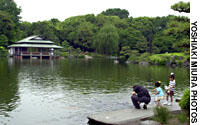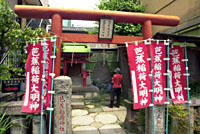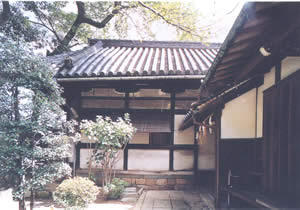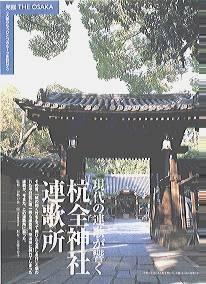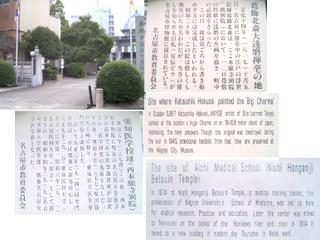:::::::::::::::::::::::::::::::::::::::::::::::::::::::::::::::::::::::::::::::::::::::::::::::::::::
Matsuo Basho, a Haiku Poet 松尾芭蕉
See below for Basho-Ki memorial day, as a kigo for haiku.
Matsuo Bashoo, Basho Matsuo, Bashoo
. Matsuo Basho - Complete Archives of the WKD .
:::::::::::::::::::::::::::::::::::::::::::::::::::::::::::::::::::::::::::::::::::::::::::::::::::::
After moving to Fukagawa, Basho wrote:
For nine springs and autumns, I lived austerely in the city. Now I have moved to the bank of the Fukagawa River. Someone once said,
"Since of old, Chang-an has been a place for fame and fortune, so hard for a wayfarer empty-handed and penniless."
Is it because I'm impoverished myself that I can understand this feeling?
柴の戸に茶の木の葉掻く嵐かな
shiba no to ni cha no konoha kaku arashi kana
Against the brushwood gate
Dead tea leaves swirl
In the stormy wind.
Tr. Makoto Ueda
This is close to a poem by Bo Juyi 白居易 Bai Juyi, Po Chu-I (772 - 846)
© More in the WIKIPEDIA !
. Chinese background of Japanese Haiku .
:::::::::::::::::::::::::::::::::::::::::::::::::::::::::::::::::::::::::::::::::::::::::::::::::::::
Basho Memorial Hall in Kyoto
芭蕉堂 Bashoo Doo
(京都市東山区南鷲尾町)


source : stonko14
:::::::::::::::::::::::::::::::::::::::::::::::::::::::::::::::::::::::::::::::::::::::::::::::::::::
Basho Memorial Day, kigo for early winter
also called
Winter Rain Anniversary (shigure ki 時雨忌, shigure-e 時雨会)
Old Master's Day (Okina no hi 翁の日)
Green Peach Day (Toosei ki 桃青忌)
'Green Peach' was Basho's pen name before he choose the Banana plant, Basho.
"Basho's Day, basho-ki, 芭蕉忌
On the 12th day of the 10th lunar month of 1694 (25 November, Gregorian), Basho, the founder of haikai and haiku as we know them today, died. He was at a stopover midway on yet another journey, in Osaka, and attended by a number of disciples. Still observed according to the lunar calendar, which varies considerably from year to year with respect to the Gregorian, the date is associated with the characteristic early WINTER DRIZZLE.
In Japanese the name of an important figure followed by ki means the person's death anniversary. In English, we have sometimes used "remembered" to suggest this...
In haikai the Master's Day or Master's Anniversary (okina no ki 翁の忌) always refers to Basho's Day."
Haiku World: An International Poetry Almanac by William J. Higginson
Quoted from Vanpire13
Basho choose the pen name Toosei 桃青 "Peach Green" in an allusion to his favorite Chinese poet
. Li Po, Li Bo, Li Bai 李白 "Plum White" .
MORE - hokku about shigure by
. Matsuo Basho 松尾芭蕉 - Archives of the WKD .
.. .. .. .. .. .. ..
There is some dispute as to the exact day of his death.
Bashô's Memorial Day (bashooki, early winter). Day 12 of the 10th lunar month, 28 Nov 1694 Gregorian.
http://renku.home.att.net/500ESWd.html
:::::::::::::::::::::::::::::::::::::::::::::::::::::::::::::::::::::::::::::::::::::::::::::::::::::::
旅に病んで夢は枯野をかけ廻る
. tabi ni yande yume wa kareno o kakemeguru .
falling ill while travelling -
in my dreams I am wandering
over withered fields
Tr. Gabi Greve
The famous Death Haiku of Matsuo Basho, day 8 of the 10th lunar month
1694 元禄7年 10月8日
Basho had been ill since day 29 of the 9th lunar month.
---------------------------------------------------------------------------------
tama matsuri kyō mo yakiba no kemuri kana
玉祭り 今日も焼場の 煙哉
At the festival of the spirits
And even at the crematory
Smoke!
Tama matsuri is a festival held to pray to, give thanks to, and appease the souls of the dead.
:::::::::::::::::::::::::::::::::::::::::::::::::::::::::::::::::::::::::::::::::::::::::::::::::::::::
FRAGMENTARY NOTES ON BASHO By Susumu Takiguchi Basho’s Death It is generally held that Basho died at the Saru-no-Koku (around 4 o’ clock in the afternoon) on the 12th day of the Kamina-zuki (October according to the lunar calendar) of the 7th year of the Genroku Era, or 1694. He was taken ill on his last journey in Osaka and came to the end of his 50 years of life at the house of Hanaya Nizaemon in Minami-Mido-Mae, watched by many of his disciples who hurriedly assembled at his bedside. (The equivalent date of his death according to the solar calendar is 28 November.) (Note) There are not a few discrepancies in the Japanese kigo in terms of regional differences (space) and historical changes (time). The discrepancies caused by the change of Japanese national calendar from the lunar to solar system in 5 Meiji (1972), when 3 December was designated 1 January 1973, are the most pronounced. Even today, there are still a lot of cases of confusion in the use of these season words and those relating to the dates of death of famous literary figures are no exception. In many cases both lunar calendar date and solar calendar date are used interchangeably, though in some cases such as that of Ariwara-no-Narihira (date of death: 28 May 880 under the lunar calendar) the same date of the lunar calendar is used to celebrate his anniversary of death even under the solar calendar (i.e. 28 May). In the case of Basho-ki, the practice is presumably mixed in the sense that some poets use the same date of the lunar calendar (12 October) even if it means that it is more than a month earlier than the precise equivalent of solar calendar (28 November). 12 of October in Japan could still be warm or even hot in some places while 28 of November could be very cold and this would give a totally different perception about the circumstances of Basho's death. .. .. .. Basho-ki The day of Basho’s death has been celebrated since soon after he died, and has been given various names of which Basho-ki is the most well-known. Other names include: Shigure-ki, Shigure-e, Okina-ki, Okina-no-hi, Tosei-ki, Basho-e. These are all used as kigo (early winter). Basho-an-Kobunko, which was edited by Fumikuni and published in 9 Genroku (1696), has a memorial haiku by the editor himself: Basho-e to moushi-some-keri zo no mae we have started to call it Basho-e before his statue Some examples of Basho-ki haiku: Basho-ki no suzuke no hiya ya Ohmi-kabu Mori Sumio Basho-ki… the cool of Ohmi turnips pickled in vinegar mizu-umi no samusa o shira-nu Okina-no-Ki Takahama Kyoshi realising the coldness of the lake, on Okina-no-ki tabi ichiya akete Okina-no-Ki nari-keri Azumi Atsushi one night on my journey, I woke up to find the day was Okina-no-ki Basho-ki ya zori ni nagomu tsuki-akari Watanabe Suiha Basho-ki... the moonlight looking comfortable on my zori sandals http://groups.yahoo.com/group/happyhaiku/message/1659 |
. Haikai Meeting at Shioe Shayo 車庸(しやよう)
1694 (Genroku 7, on the 21st day of the ninth lunar month) in Osaka
quote
In Kareobana 枯尾華 (Withered Plumes of Grass, 1694), his moving account of Basho's last hours, Kikaku mentioned that there were now more than twothousand disciples all over the country.
The number kept increasing, even after Basho's death, as everyone who had ever joined in making haikai poetry with even the least important of the original disciples proudly claimed to be a disciple himself. This naturally annoyed the 'direct disciples' (who probably numbered no more than sixty), and one threated to denounce all imposters.
World Within Walls
Donald Keene
.................................................................................
Two german researchers, Udo Wenzel and Gerhard P. Peringer have found various dates for this day, for example
October 12, November 8, November 25 and November 28 of 1694

Read it all here in German:
http://kulturserver-nds.de/home/haiku-dhg/Archiv/Wenzel_Bashos%20Todestag.htm
backup copy
. - Hanaya Nizaemon 花屋仁左衛門 - .
and the death of Basho in Osaka 大坂南御堂前
. Basho's Grave at - Gichuuji 義仲寺 Temple Gichu-Ji - .
:::::::::::::::::::::::::::::::::::::::::::::::::::::::::::::::::::::::::::::::::::::::::::::::::::::
HAIKU
ばせを忌やことしもまめで旅虱
bashôki ya kotoshi mo mame de tabi-jirami
Basho's Death-Day--
another year in good health
my journey's lice
.. .. ..
翁忌や何やらしゃべる門雀
okina-ki ya naniyara shaberu kado suzume
Basho's Death-Day--
what are you chattering
sparrows at the gate?
Read 17 haiku by Issa, translated by David Lanoue.
http://cat.xula.edu/issa/searchissa.php?s_string=basho&sorter=date
:::::::::::::::::::::::::::::::::::::::::::::::::::::::::::::::::::::::::::::::::::::::::::::::::::::::
芭蕉忌や我俳諧の奈良茶飯
bashooki ya waga haikai no nara chameshi
Basho Memorial Day -
for our haikai meeting
rice gruel from Nara
. Masaoka Shiki 正岡子規 .
. NARACHA 奈良茶 Basho and Haikai .
Matsuo Basho was very fond of Naracha rice gruel.
.......................................................................
遷宮の年の芭蕉忌修すべし
senguu no toshi no bashooki shusubeshi
in this year of renewal of the Ise Shrine
we should celebrate
Basho's Memorial Day
Ozawa Minoru 小澤實
. WKD : Ise gosenguu 伊勢御遷宮
transposition of Ise shrine's sanctuary .
Basho was able to attend the rituals in his time !
芭蕉忌やロードバイクは濡れそぼつ
bashooki ya roodobaiku wa nuresobotsu
Basho Memorial Day -
the road bike is dripping
from rain
Oohashi Kazue 大橋一恵
芭蕉忌や文字摺石は除染中
. bashooki ya mojizuri ishi wa josenchuu .
Chinen Tetsuo 知念哲夫 -
the stone in Fukushima must now be decontaminated from radioactive substances.
- reference - NHK haiku November 2013 -
:::::::::::::::::::::::::::::::::::::::::::::::::::::::::::::::::::::::::::::::::::::::::::::::::::::::
Basho-ki ya zori ni nagomu tsuki-akari
Basho-Tag ...
das Mondlicht behaglich
auf meinen Strohsandalen
Watanabe Suiha, 1882 – 1946
.. .. ..
mizu-umi no samusa wo shiri-nu Okina-no-ki
ich spüre
die Kälte vom See —
des Alten Meisters Gedenktag
(Takahama Kyoshi, 1874 – 1959)
(Übersetzungen von Gabi Greve und Udo Wenzel)
http://kulturserver-nds.de/home/haiku-dhg/Archiv/Wenzel_Bashos%20Todestag.htm
ume ga ka ni notto hi no deru yamaji kana
梅が香にのっと日の出 山路かな
in the fragrance of plum blossoms
the sun comes out
on this mountain road
Click on the haiku to see the memorial stone in Doi, Okayama prefecture.
:::::::::::::::::::::::::::::::::::::::::::::::::::::::::::::::::::::::::::::::::::::::::::::::::::::
Read about the Renku Meeting Halls in Old Osaka.
Hirano Rengasho 平野連歌所
External LINK
Photos and Illustrations about Basho
松尾芭蕉ノート..
*****************************
WKD : More about
Matsuo Basho
Sound of Water (mizu no oto) and how to translate it ...
Kitamuki Unchiku ... 北向雲竹 Calligraphy teacher of Basho.
:::::::::::::::::::::::::::::::::::::::::::::::::::::::::::::::::::::::::::::::::::::::::::::::::::::

. - Basho Inari Jinja 芭蕉稲荷神社 Basho Fox Shrine - .
okiwa, Koto Ward 江東区常盤1-3, Tokyo

More photos
source : tetsuyosie
. . . CLICK here for more Photos !
. - Bashō-An 芭蕉庵 Basho-An in Fukagawa 深川 - .
- - - - - and
Sekiguchi Bashoan 関口芭蕉庵 Sekiguchi Basho-An
:::::::::::::::::::::::::::::::::::::::::::::::::::::::::::::::::::::::::::::::::::::::::::::::::::::
. Basho on Stamps 切手 kitte .
:::::::::::::::::::::::::::::::::::::::::::::::::::::::::::::::::::::::::::::::::::::::::::::::::::::
under a basho ...
the old man scribbles
in the dirt
Don Baird
:::::::::::::::::::::::::::::::::::::::::::::::::::::::::::::::::::::::::::::::::::::::::::::::::::::
. Timeline - his life and work .
MORE
. Matsuo Basho - Archives of the WKD .
. more EXTERNAL LINKS .
WKD : Matsuo Basho, the Haiku Poet
[ . BACK to WORLDKIGO TOP . ]
[ . BACK to DARUMA MUSEUM TOP . ]
:::::::::::::::::::::::::::::::::::::::::::::::::::::::::::::::::::::::::::::::::::::::::::::::::::::
